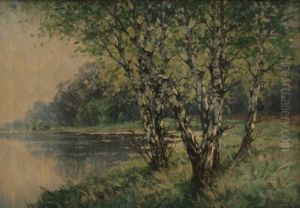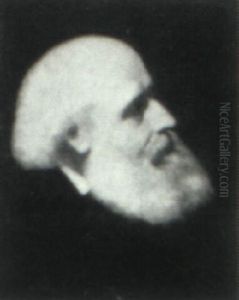Ilya Semenovich Ostroukhov Paintings
Ilya Semenovich Ostroukhov was a distinguished Russian artist, art collector, and theorist, born on April 3, 1858, in Moscow. He was a prominent figure in the Russian art world at the turn of the 20th century, known for his contributions to landscape painting and for his pivotal role in the development of the Russian art conservation movement. Ostroukhov's upbringing in a wealthy merchant family allowed him to pursue his interests in art from an early age, though he initially embarked on a career in the sciences, graduating from the Moscow University with a degree in natural sciences. His passion for art, however, led him to switch careers, dedicating his life to painting, collecting, and art preservation.
Ostroukhov was deeply influenced by the traditional Russian landscape, and his works often reflect his profound appreciation and understanding of nature. He was associated with the Peredvizhniki (Wanderers) – a cooperative of realist artists who sought to break away from the academic restrictions of the Russian art scene, promoting instead an art that was accessible and relevant to the general public. Ostroukhov's landscapes are notable for their meticulous attention to detail, vibrant use of color, and emotive portrayal of the Russian countryside. Among his most celebrated works are 'Golden Autumn' and 'In the North. Wilds.'
Beyond his artistic creations, Ostroukhov was an avid art collector and played a significant role in the preservation of Russian cultural heritage. He amassed an extensive collection of Russian icons, old master paintings, and works by contemporary Russian artists. His Moscow home, known as the Ostroukhov House, became a cultural hub, hosting meetings for artists, musicians, and writers, and eventually turned into a museum of Russian art and icons, testament to his legacy as a patron of the arts.
Ostroukhov also engaged in art theory and criticism, writing on various aspects of art history and conservation. He was instrumental in founding the Moscow Society of Art Lovers and played a key role in the establishment of the Tretyakov Gallery, one of Russia's foremost art museums. His contributions extended to teaching, where he influenced a generation of Russian artists and art historians.
Ilya Semenovich Ostroukhov's death on April 14, 1929, marked the end of a life dedicated to the enrichment and preservation of Russian art. His legacy is evident not only in his artistic works but also in his efforts to safeguard and promote Russia's cultural heritage. Ostroukhov remains a respected figure in Russian art history, celebrated for his landscapes, his collection, and his unwavering commitment to the arts.








